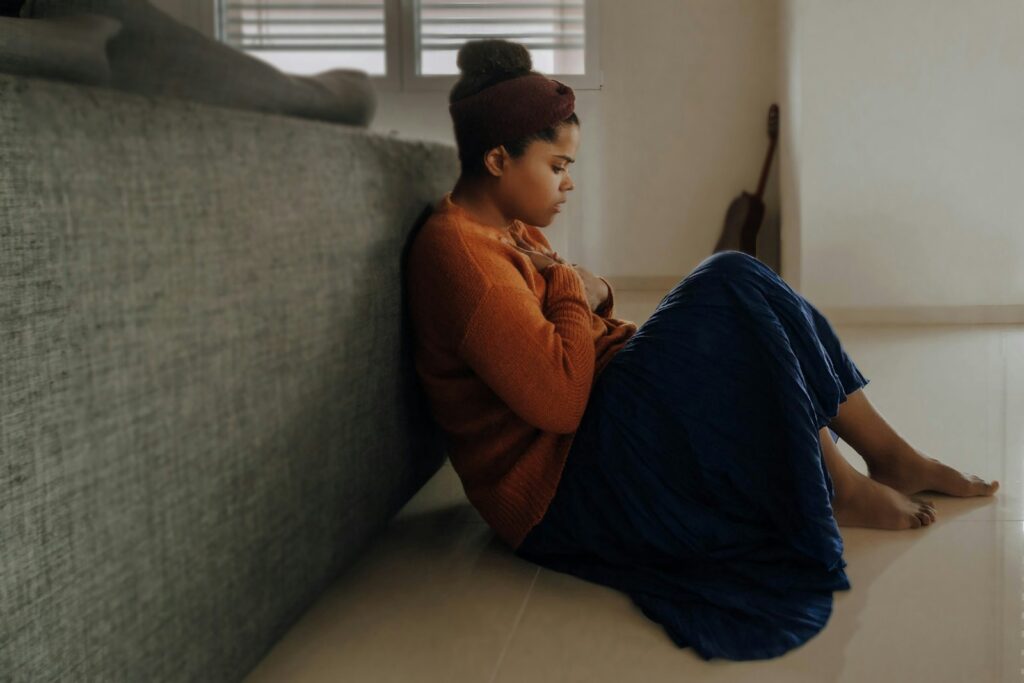Are you wondering “does everyone have anxiety”?
Anxiety is a universal human experience. Nearly everyone has felt anxious before a big event, during a stressful situation, or when faced with an uncertain outcome. But when does typical anxiety cross over into a more serious concern, such as an anxiety disorder? Understanding where this line lies is essential for identifying, addressing, and managing symptoms effectively.
Increasing awareness about anxiety disorders is crucial for ensuring that individuals seek the help they need.
This post is here to help. We’ll explore the difference between normal anxiety and anxiety disorders, discuss the different types of anxiety conditions, and provide actionable steps for coping, managing, and seeking treatment. Whether you’re someone who experiences anxiety occasionally or struggles with it for an extended period, you’ll find insights to help you take control.

Photo by Joice Kelly on Unsplash
Introduction to Anxiety Disorders
Anxiety is a natural response to perceived or actual danger. It’s your brain’s way of alerting you to threats, helping you prepare to handle them. However, when anxiety becomes excessive, chronic, or severe and begins to interfere with daily activities, relationships, or job performance, it could signal an anxiety disorder.
Ready to Start Therapy?
Your healing journey can begin today. Fill out the form below to connect with a therapist who truly listens and understands.
What Sets Anxiety Disorders Apart?
Anxiety disorders encompass a range of mental disorders characterized by persistent feelings of worry, fear, or panic that interfere with normal life. Unlike regular feelings of anxiety, these disorders often occur without an apparent reason or in response to everyday situations.
- Physical symptoms like increased heart rate, nausea, or muscle tension.
- Psychological symptoms such as irrational fear, persistent worry, or feelings of impending danger.
- Behavioral symptoms like avoidance or significant changes in how someone interacts with their social or professional environments.
In addition to these, other symptoms of anxiety disorders can include behavioral and cognitive changes that further impact daily life.
While these disorders can feel overwhelming, they can also be successfully treated with various therapies, including dialectial behavioural therapy (DBT), cognitive behavioural therapy (CBT) and exposure therapy, enhancing quality of life.

Photo by Uday Mittal on Unsplash
Types of Anxiety Conditions
Anxiety manifests in several types of conditions, each with distinct characteristics:
1. Generalized Anxiety Disorder (GAD)
GAD involves excessive anxiety and worry about various aspects of life, such as relationships, finances, or job performance, often to the point where it significantly impacts daily activities.
GAD is particularly prevalent among adults, significantly impacting their daily activities and overall quality of life.
2. Social Anxiety Disorder
Those with social anxiety disorder experience severe fear or worry in social settings. This can range from avoiding public speaking to struggling with routine interactions, which can lead to profound isolation. For example, joining a supportive organization like Toastmasters can help individuals confront and mitigate social anxiety effectively.
3. Panic Disorder
Panic disorder involves recurring, intense episodes of panic attacks. These can arise without a specific situation triggering them and involve symptoms like shortness of breath, chest pain, and a sense of impending doom.
4. Specific Phobias
Phobias are characterized by an irrational fear of specific situations, objects, or activities, such as heights (acrophobia), spiders (arachnophobia), or flying.
5. Post-Traumatic Stress Disorder (PTSD)
Although linked to trauma, PTSD is considered an anxiety-related disorder. It includes symptoms such as flashbacks, avoidance of reminders of the trauma, and hypervigilance. PTSD often involves intense fears related to the traumatic event, which can significantly impact daily life.
6. Obsessive-Compulsive Disorder (OCD)
OCD involves unwanted repetitive thoughts (obsessions) and the urge to perform repetitive behaviors (compulsions). These may arise to reduce a person’s anxiety but interfere with life.
7. Separation Anxiety Disorder
Often affecting younger individuals, separation anxiety disorder involves excessive fear associated with being away from a significant caregiver or loved one. This disorder is particularly common among children and adolescents, significantly impacting their emotional well-being.
Understanding which type of anxiety you or someone you care about might be experiencing is a critical first step in seeking treatment.
The Impact of Anxiety on Daily Life
Anxiety doesn’t just affect those quiet moments in your head; it impacts lives, disrupting social life, career, physical health, and relationships.
1. Relationships and Social Life
Anxiety can lead to avoidance behavior, causing people to distance themselves from friends and family or avoid social gatherings, leading to loneliness and isolation. Addressing these concerns through mental health support is crucial for improving social relationships.
2. Job Performance and Productivity
Those dealing with anxiety may find it hard to focus, stay productive, or handle workplace challenges, which can lead to stress and decreased job satisfaction. These difficulties can lead to stress and decreased job satisfaction, further exacerbating anxiety.
3. Physical Health Effects
Chronic anxiety can result in adverse effects on the body, such as high blood pressure, weakened immunity, and an increased risk of cardiovascular diseases.
4. Emotional Well-Being
Left unchecked, anxiety infringes on emotional health, causing feelings of hopelessness, difficulty in maintaining self-esteem, and even contributing to depression. Self-care plays an important role in maintaining emotional well-being and managing anxiety.
Treatment and Management
Thankfully, there are many effective treatments and self-care strategies available for managing anxiety. In some cases, medication can be an effective complement to therapy for managing anxiety symptoms.
Professional Treatments
- There are several types of professional treatments available for managing anxiety. Cognitive Behavioral Therapy (CBT) stands as the gold standard for many anxiety disorders. It helps you identify and challenge negative thought patterns that drive anxiety.
- Exposure Therapy gradually helps patients confront specific anxiety triggers in a controlled setting, reducing avoidance behavior and fear over time.
- Medications, such as antidepressants or anti-anxiety medications, can be helpful when used under the guidance of a healthcare professional.
Self-Care Strategies
- Relaxation Techniques: Practices like slow breathing, meditation, or progressive muscle relaxation can significantly reduce symptoms during moments of acute anxiety. Practices like slow breathing signal to the brain that everything is safe, helping to reduce anxiety.
- Physical Well-being: Regular exercise, a healthy diet, and adequate sleep improve overall mental health.
- Limiting Caffeine and Alcohol minimizes substances that exacerbate symptoms.
Overcoming Anxiety
Overcoming anxiety is not about eradicating it entirely but learning to manage and cope with it effectively. Learning to manage symptoms of anxiety is key to overcoming its impact on daily life.
Build a Support Network
Support from friends, family, and professionals plays a critical role in recovery. Sharing your struggles can help reduce the weight anxiety puts on you.
Engage in Activities You Love
Participating in enjoyable experiences can redirect focus from excessive worrying to more fulfilling pursuits, promoting emotional balance. For example, engaging in hobbies like painting or gardening can provide a positive distraction from anxiety.
Recognize When to Seek Help
If anxiety begins to interfere with daily life, relationships, or job performance, seeking help from a trained mental health professional is a critical step.
Anxiety disorders affect a significant portion of the population, making it important to seek help when needed.

Photo by Fernando @cferdophotography on Unsplash
Does Everyone Have Anxiety? | Take the First Step Toward Relief
Anxiety might feel overwhelming, but it is manageable, treatable, and does not define your lives. Through therapies like DBT, lifestyle adjustments, and self-care, you can regain control over your mental well-being and improve your quality of life.
If you feel anxiety is negatively impacting your life or wonder if your symptoms align with an anxiety disorder, it’s time to seek expert guidance. Book a consultation today with Dr. Mandelbaum, who specializes in anxiety treatment. Together, we can find the calm amidst the worry.
Anxiety Resources
If you or a loved one is dealing with anxiety, the following resources can provide support, information, and guidance for managing your mental health effectively:
- National Institute of Mental Health (NIMH) – Visit the NIMH website for reliable information about anxiety disorders, their symptoms, and available treatments.
- Anxiety and Depression Association of America (ADAA) – Explore detailed resources on anxiety, depression, and related conditions at the ADAA website. The site includes tips for managing stress, finding a therapist, and joining support groups.
- Mindfulness-Based Stress Reduction (MBSR) – Learn about evidence-based mindfulness techniques that can reduce anxiety and stress at The Center for Mindfulness.
- National Alliance on Mental Illness (NAMI) – NAMI provides a range of resources, from educational materials to peer-led support groups. Their NAMI Helpline is available for free and offers guidance and information to help individuals and families affected by mental health conditions.
- Mental Health America (MHA) – Mental Health America is a leading nonprofit dedicated to addressing the needs of those living with mental health conditions and promoting overall mental wellness. Their Online Screening Tools are a great resource for individuals to assess their mental health and seek appropriate support.
- Crisis Text Line – Crisis Text Line provides free, 24/7 support to individuals in crisis. By texting HOME to 741741, users are connected with a trained volunteer who can provide support and help develop a plan to manage the situation. More information is available on their official website.
- Headspace – Headspace is a popular meditation app designed to support mindfulness and mental well-being. It offers guided meditations, stress-relief exercises, and sleep aids to help users manage anxiety, improve focus, and develop healthier habits. Learn more on their official website.
- Calm – Calm provides a wide range of resources to promote relaxation and mindfulness, including guided meditations, breathing exercises, and soothing background sounds. It is an excellent tool to help reduce stress, improve sleep quality, and cultivate a sense of calm. Visit their official website for more details.
These resources can help you take the first steps toward understanding and coping with anxiety, whether it’s for yourself or someone you care about. Don’t hesitate to reach out for support—you don’t have to face it alone.


